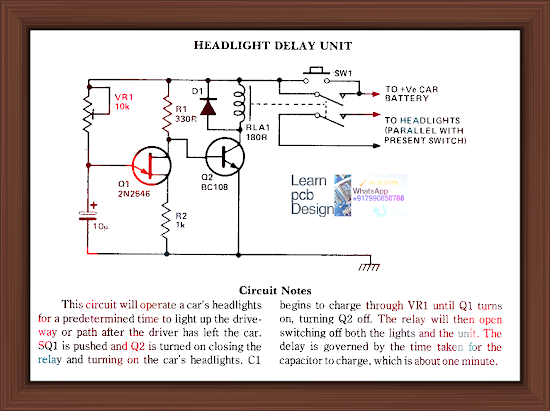Car Headlight Delay Circuit: A Complete Guide
Car Headlight Delay Circuit
Introduction:
A car headlight delay circuit is a device that turns on the headlights of a car for a predetermined amount of time after the driver has turned off the ignition. This can be useful for a variety of reasons, such as:
- To illuminate the driver's path as they walk away from the car
- To provide light for other drivers and pedestrians
- To deter crime
The circuit in the image is a simple and effective car headlight delay circuit that can be built using a few common electronic components. In this blog post, we will take a closer look at the circuit, explain how it works, and discuss its advantages and practical applications.
Components for Car Headlight Delay Circuit
The circuit is made up of six main components:
- 12-volt power source: This can be the car's battery or another 12-volt power supply.
- 10K potentiometer: This is used to set the delay time. The higher the resistance of the potentiometer, the longer the delay time will be.
- NPN transistor: This is used to switch the headlights on and off.
- Relay: This is used to amplify the current from the transistor to turn on the headlights.
- Headlights: These are the lights that will be turned on by the circuit.
- Resistor: This is used to limit the current that flows through the relay coil.
Wiring for Car Headlight Delay Circuit
The circuit is wired as follows:
- The positive terminal of the power source is connected to the collector of the transistor.
- The negative terminal of the power source is connected to the ground of the circuit.
- The wiper of the potentiometer is connected to the base of the transistor.
- The emitter of the transistor is connected to the coil of the relay.
- The normally-closed contacts of the relay are connected to the headlights.
- The normally-open contacts of the relay are connected to the ground of the circuit.
- The resistor is connected in series with the coil of the relay.
Operation of the Car Headlight Delay Circuit
When the driver turns off the ignition, the power to the circuit is cut off. This causes the transistor to turn off, which in turn causes the relay to turn off. This breaks the connection between the headlights and the ground of the circuit, so the headlights turn on.
The headlights will stay on for a predetermined amount of time, depending on the setting of the potentiometer. After the delay time has elapsed, the transistor will turn on again, which will cause the relay to turn off. This breaks the connection between the headlights and the power source, so the headlights turn off.
Advantages of the Car Headlight Delay Circuit
The car headlight delay circuit has several advantages, including:
- It is very simple to build. The circuit can be built using a few common electronic components that are readily available.
- It is very effective. The circuit can reliably turn on the headlights for a predetermined amount of time.
- It is very affordable. The cost of the components required to build the circuit is very low.
Practical Usage:
The car headlight delay circuit can be used for a variety of practical purposes, including:
- To illuminate the driver's path as they walk away from the car. This can help to prevent the driver from tripping or falling in the dark.
- To provide light for other drivers and pedestrians. This can help to improve visibility and safety on the road.
- To deter crime. The headlights can act as a deterrent to criminals, as they will be more likely to be seen if they attempt to commit a crime in a well-lit area.
Formulas and Calculations:
The delay time of the circuit can be calculated using the following formula:
Delay time (seconds) = R1 * C1
Where:
- R1 is the resistance of the potentiometer (in ohms)
- C1 is the capacitance of the capacitor (in farads)
For example, if R1 is 10K ohms and C1 is 10μF, then the delay time will be 1 second.
Conclusion:
In conclusion, the car headlight delay circuit is a simple and effective device that can be used for a variety of practical purposes. The circuit is very easy to build and affordable to construct.
The circuit can be used to illuminate the driver's path as they walk away from the car, to provide light for other drivers and pedestrians, and to deter crime. The delay time of the circuit can be calculated using a simple formula, and the circuit can be modified to accommodate different needs.
If you are looking for a way to improve the safety of your car and the well-being of your passengers, the car headlight delay circuit is a great option. It is a simple and affordable way to add a layer of safety to your vehicle.
learn more ...
The Smallest Car Battery Monitor Circuit: A Complete Guide
Demystifying Windshield Wiper Controller Circuits: A Deep Dive into Components and Functionality
https://learnpcbdesignonline.blogspot.com/2023/08/demystifying-windshield-wiper.html
------------------------------------------------------------------------















No comments:
Post a Comment